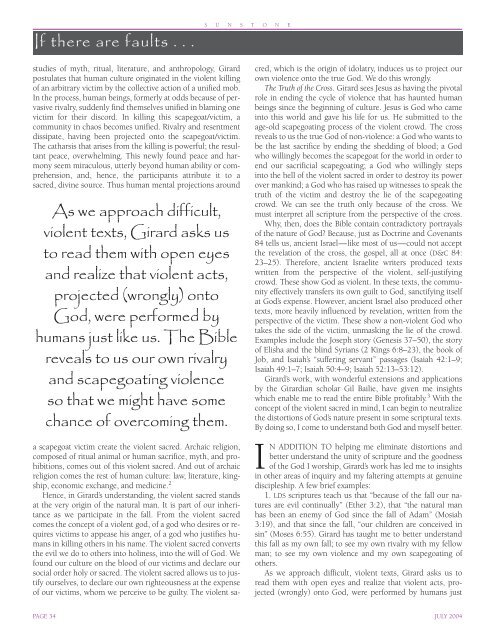is there a place for heavenly mother in mormon theology?
is there a place for heavenly mother in mormon theology?
is there a place for heavenly mother in mormon theology?
Create successful ePaper yourself
Turn your PDF publications into a flip-book with our unique Google optimized e-Paper software.
If <strong>there</strong> are faults . . .<br />
S U N S T O N E<br />
studies of myth, ritual, literature, and anthropology, Girard<br />
postulates that human culture orig<strong>in</strong>ated <strong>in</strong> the violent kill<strong>in</strong>g<br />
of an arbitrary victim by the collective action of a unified mob.<br />
In the process, human be<strong>in</strong>gs, <strong>for</strong>merly at odds because of pervasive<br />
rivalry, suddenly f<strong>in</strong>d themselves unified <strong>in</strong> blam<strong>in</strong>g one<br />
victim <strong>for</strong> their d<strong>is</strong>cord. In kill<strong>in</strong>g th<strong>is</strong> scapegoat/victim, a<br />
community <strong>in</strong> chaos becomes unified. Rivalry and resentment<br />
d<strong>is</strong>sipate, hav<strong>in</strong>g been projected onto the scapegoat/victim.<br />
The cathars<strong>is</strong> that ar<strong>is</strong>es from the kill<strong>in</strong>g <strong>is</strong> powerful; the resultant<br />
peace, overwhelm<strong>in</strong>g. Th<strong>is</strong> newly found peace and harmony<br />
seem miraculous, utterly beyond human ability or comprehension,<br />
and, hence, the participants attribute it to a<br />
sacred, div<strong>in</strong>e source. Thus human mental projections around<br />
As we approach difficult,<br />
violent texts, Girard asks us<br />
to read them with open eyes<br />
and realize that violent acts,<br />
projected (wrongly) onto<br />
God, were per<strong>for</strong>med by<br />
humans just like us. The Bible<br />
reveals to us our own rivalry<br />
and scapegoat<strong>in</strong>g violence<br />
so that we might have some<br />
chance of overcom<strong>in</strong>g them.<br />
a scapegoat victim create the violent sacred. Archaic religion,<br />
composed of ritual animal or human sacrifice, myth, and prohibitions,<br />
comes out of th<strong>is</strong> violent sacred. And out of archaic<br />
religion comes the rest of human culture: law, literature, k<strong>in</strong>gship,<br />
economic exchange, and medic<strong>in</strong>e. 2<br />
Hence, <strong>in</strong> Girard’s understand<strong>in</strong>g, the violent sacred stands<br />
at the very orig<strong>in</strong> of the natural man. It <strong>is</strong> part of our <strong>in</strong>heritance<br />
as we participate <strong>in</strong> the fall. From the violent sacred<br />
comes the concept of a violent god, of a god who desires or requires<br />
victims to appease h<strong>is</strong> anger, of a god who justifies humans<br />
<strong>in</strong> kill<strong>in</strong>g others <strong>in</strong> h<strong>is</strong> name. The violent sacred converts<br />
the evil we do to others <strong>in</strong>to hol<strong>in</strong>ess, <strong>in</strong>to the will of God. We<br />
found our culture on the blood of our victims and declare our<br />
social order holy or sacred. The violent sacred allows us to justify<br />
ourselves, to declare our own righteousness at the expense<br />
of our victims, whom we perceive to be guilty. The violent sacred,<br />
which <strong>is</strong> the orig<strong>in</strong> of idolatry, <strong>in</strong>duces us to project our<br />
own violence onto the true God. We do th<strong>is</strong> wrongly.<br />
The Truth of the Cross. Girard sees Jesus as hav<strong>in</strong>g the pivotal<br />
role <strong>in</strong> end<strong>in</strong>g the cycle of violence that has haunted human<br />
be<strong>in</strong>gs s<strong>in</strong>ce the beg<strong>in</strong>n<strong>in</strong>g of culture. Jesus <strong>is</strong> God who came<br />
<strong>in</strong>to th<strong>is</strong> world and gave h<strong>is</strong> life <strong>for</strong> us. He submitted to the<br />
age-old scapegoat<strong>in</strong>g process of the violent crowd. The cross<br />
reveals to us the true God of non-violence: a God who wants to<br />
be the last sacrifice by end<strong>in</strong>g the shedd<strong>in</strong>g of blood; a God<br />
who will<strong>in</strong>gly becomes the scapegoat <strong>for</strong> the world <strong>in</strong> order to<br />
end our sacrificial scapegoat<strong>in</strong>g; a God who will<strong>in</strong>gly steps<br />
<strong>in</strong>to the hell of the violent sacred <strong>in</strong> order to destroy its power<br />
over mank<strong>in</strong>d; a God who has ra<strong>is</strong>ed up witnesses to speak the<br />
truth of the victim and destroy the lie of the scapegoat<strong>in</strong>g<br />
crowd. We can see the truth only because of the cross. We<br />
must <strong>in</strong>terpret all scripture from the perspective of the cross.<br />
Why, then, does the Bible conta<strong>in</strong> contradictory portrayals<br />
of the nature of God? Because, just as Doctr<strong>in</strong>e and Covenants<br />
84 tells us, ancient Israel—like most of us—could not accept<br />
the revelation of the cross, the gospel, all at once (D&C 84:<br />
23–25). There<strong>for</strong>e, ancient Israelite writers produced texts<br />
written from the perspective of the violent, self-justify<strong>in</strong>g<br />
crowd. These show God as violent. In these texts, the community<br />
effectively transfers its own guilt to God, sanctify<strong>in</strong>g itself<br />
at God’s expense. However, ancient Israel also produced other<br />
texts, more heavily <strong>in</strong>fluenced by revelation, written from the<br />
perspective of the victim. These show a non-violent God who<br />
takes the side of the victim, unmask<strong>in</strong>g the lie of the crowd.<br />
Examples <strong>in</strong>clude the Joseph story (Genes<strong>is</strong> 37–50), the story<br />
of El<strong>is</strong>ha and the bl<strong>in</strong>d Syrians (2 K<strong>in</strong>gs 6:8–23), the book of<br />
Job, and Isaiah’s “suffer<strong>in</strong>g servant” passages (Isaiah 42:1–9;<br />
Isaiah 49:1–7; Isaiah 50:4–9; Isaiah 52:13–53:12).<br />
Girard’s work, with wonderful extensions and applications<br />
by the Girardian scholar Gil Bailie, have given me <strong>in</strong>sights<br />
which enable me to read the entire Bible profitably. 3 With the<br />
concept of the violent sacred <strong>in</strong> m<strong>in</strong>d, I can beg<strong>in</strong> to neutralize<br />
the d<strong>is</strong>tortions of God’s nature present <strong>in</strong> some scriptural texts.<br />
By do<strong>in</strong>g so, I come to understand both God and myself better.<br />
IN ADDITION TO help<strong>in</strong>g me elim<strong>in</strong>ate d<strong>is</strong>tortions and<br />
better understand the unity of scripture and the goodness<br />
of the God I worship, Girard’s work has led me to <strong>in</strong>sights<br />
<strong>in</strong> other areas of <strong>in</strong>quiry and my falter<strong>in</strong>g attempts at genu<strong>in</strong>e<br />
d<strong>is</strong>cipleship. A few brief examples:<br />
1. LDS scriptures teach us that “because of the fall our natures<br />
are evil cont<strong>in</strong>ually” (Ether 3:2), that “the natural man<br />
has been an enemy of God s<strong>in</strong>ce the fall of Adam” (Mosiah<br />
3:19), and that s<strong>in</strong>ce the fall, “our children are conceived <strong>in</strong><br />
s<strong>in</strong>” (Moses 6:55). Girard has taught me to better understand<br />
th<strong>is</strong> fall as my own fall; to see my own rivalry with my fellow<br />
man; to see my own violence and my own scapegoat<strong>in</strong>g of<br />
others.<br />
As we approach difficult, violent texts, Girard asks us to<br />
read them with open eyes and realize that violent acts, projected<br />
(wrongly) onto God, were per<strong>for</strong>med by humans just<br />
PAGE 34 JULY 2004
















